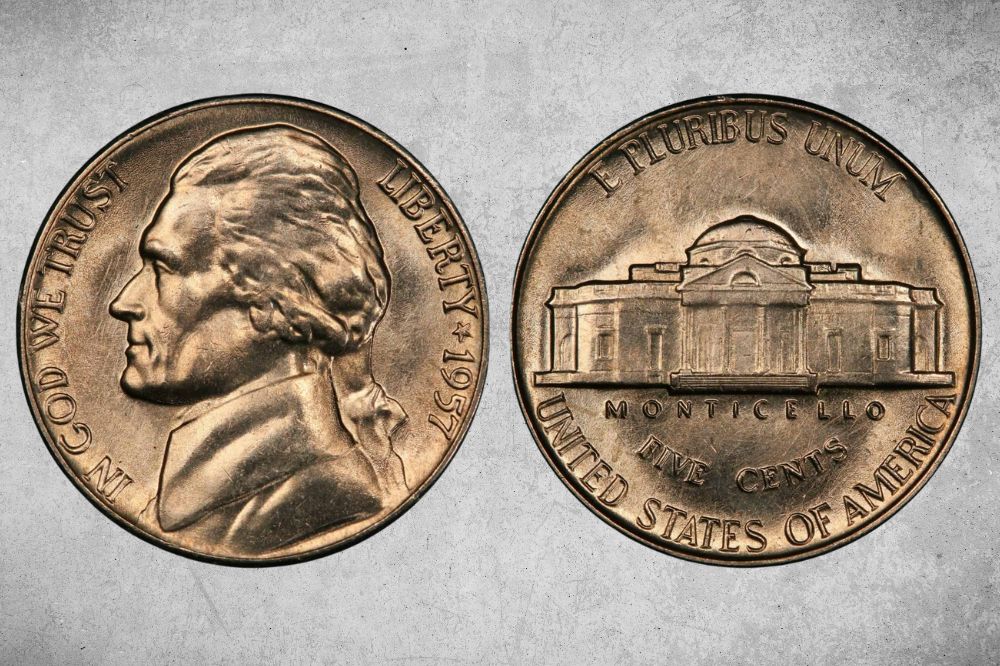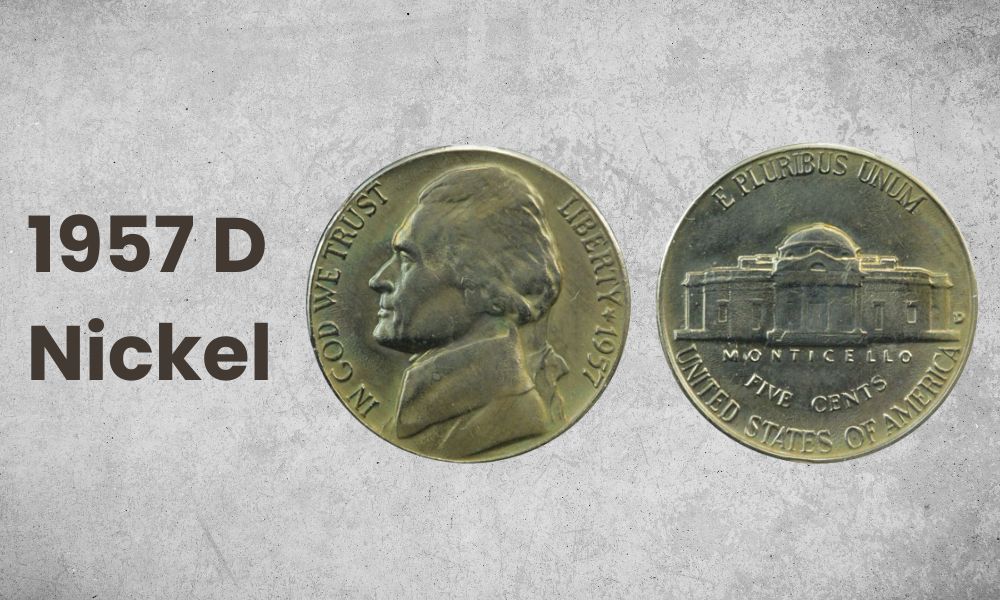Have you found a nickel from 1957 amongst your pocket change? Or are you a collector considering buying such a coin? Either way, you’ll be interested to know how much it’s worth. And that’s where we come in!
We’re going to investigate the 1957 nickel value. We’ll find out about the different varieties and errors. And we’ll discover just how much difference condition can make to price.
Ready to find out more about this interesting coin? Let’s get started!
1957 Nickel Details
- Category: Jefferson nickels
- Mints: Philadelphia, Denver
- Total mintage: 141,916,852
- Designer: Felix Schlag
- Edge: Plain
- Diameter: 21.2 millimeters
- Composition: 75% copper, 25% nickel
- Weight: 5.0 grams
1957 Nickel Value Chart |
||||
| Mint Mark and Color | XF45 | MS60 | MS65 | MS67 |
| 1957 (P) No Mint Mark Nickel Value | $0.05 | $2 | $24
Full Step: $80 |
$500
Full Step: $3,500 |
| 1957 D Nickel Value | $0.05 | $2 | $20
Full Step: $110 |
$260
Full Step: $15,000 |
| PR50 | PR60 | PR65 | PR69 | |
| 1957 (P) No Mint Mark Proof Nickel Value | $2 | $6 | $12
Cameo: $70 |
$550
Cameo: $3,500 |
1957 Nickel Values and Varieties Guides
1957 (P) No Mint Mark Nickel Value
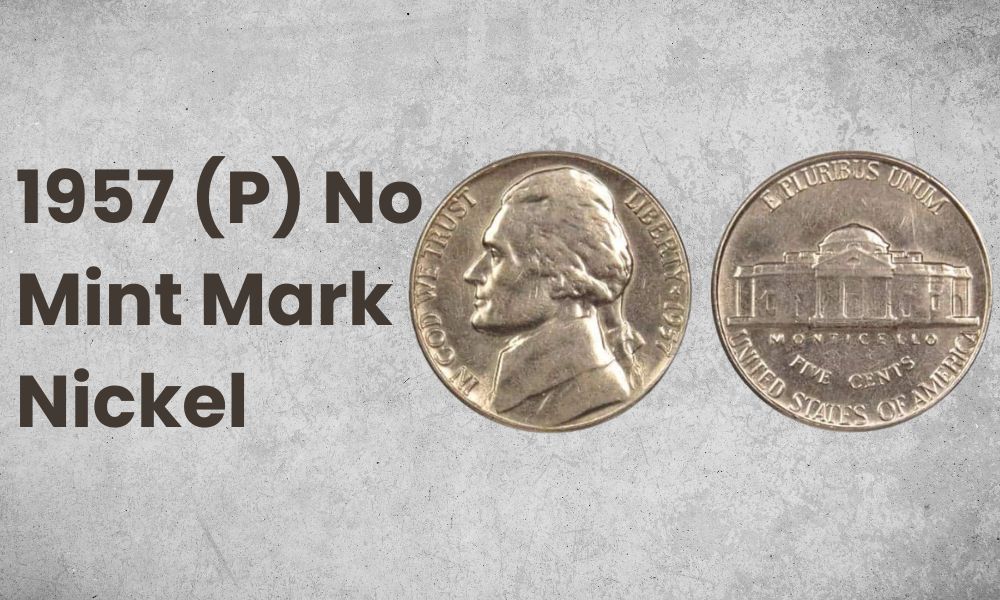
- Type: Jefferson nickel
- Edge: Plain
- Mint mark: None
- Place of minting: Philadelphia
- Year of minting: 1957
- Face value: $0.05
- $ price: $0.05 to $3,500
- Quantity produced: 38,400,000
- Designer: Felix Schlag
If your 1957 nickel doesn’t have a mint mark, it was produced in Philadelphia. As the first of the US Mint facilities, Philadelphia didn’t need to distinguish its coins from those produced elsewhere.
Over 38 million nickels were minted in Philly that year. They’re still easy to find, which means that most coins in circulated condition aren’t worth more than their face value.
The exception is nickels graded 1 on the coin grading scale. That grade is awarded to a coin in the poorest possible condition, whilst still being identifiable. Some collectors specialize in these coins, and a 1957 nickel graded 1 is worth about $10.
Values increase for coins in uncirculated condition, known as “mint state”. These are graded from 60 to the maximum 70 on the grading scale. The numbers are prefixed with “MS” to indicate their mint state.
A 1957 Philadelphia nickel graded MS60 is worth around $2. That increases to $24 for an example graded MS65, the lowest grade at which a coin is termed “gem quality”.
The highest standard 1957 Philadelphia nickels known to exist are three coins graded MS67+ by independent coin assessors the NGC. One of these sold at auction in 2021 for $588.
But some nickels are also awarded the designation “Full Step”, often abbreviated to “FS” in coin catalogs. This marks out a coin with a superior strike.
The step in question refers to the design on the reverse of the coin. That shows Monticello, the home of President Jefferson. And leading up to the building is a flight of steps. If all six steps are shown clearly, the coin is designated “Full Step”.
These are rarer than standard nickels, and hence more valuable. Coin assessors the PCGS value a full step 1957 Philadelphia nickel graded MS65 at $80. That’s more than three times as much as a standard nickel at the same grade.
And the most valuable full step 1957 Philadelphia nickels known to exist are four coins graded MS67. The PCGS values those at $3,500 apiece.
1957 D Nickel Value
- Type: Jefferson nickel
- Edge: Plain
- Mint mark: D
- Place of minting: Denver
- Year of minting: 1957
- Face value: $0.05
- $ price: $0.05 to $15,000
- Quantity produced: 136,828,900
- Designer: Felix Schlag
The mint mark on a 1957 Denver nickel appears on the reverse. Look for it just to the right of the image of Monticello. If there’s a small “D”, your coin was minted in Denver.
That facility produced over 138 million nickels in 1957. So, as with Philadelphia examples, most coins in circulated condition are worth only their face value. The exception is again coins graded 1, which will be worth around $10.
Values are higher for uncirculated coins, and the better the condition, the more valuable they’ll be. The PCGS values a coin at MS60 at $2 without the “Full Step” designation, and $5 with it. That increases to $20 and $110 respectively at MS65.
The PCGS attaches considerably higher values to “Full Step” coins at grades MS66+ and MS67 – $2,500 and $15,000. But actual sale prices tell a considerably more conservative story about value.
16 coins have so far been graded MS66+ FS, and two of these sold at separate auctions in 2020. On those occasions, they made $1,200 and $1,528. And the last MS67 FS nickel was auctioned in 2021, when it sold for just $1,020.
1957 (P) No Mint Mark Proof Nickel Value
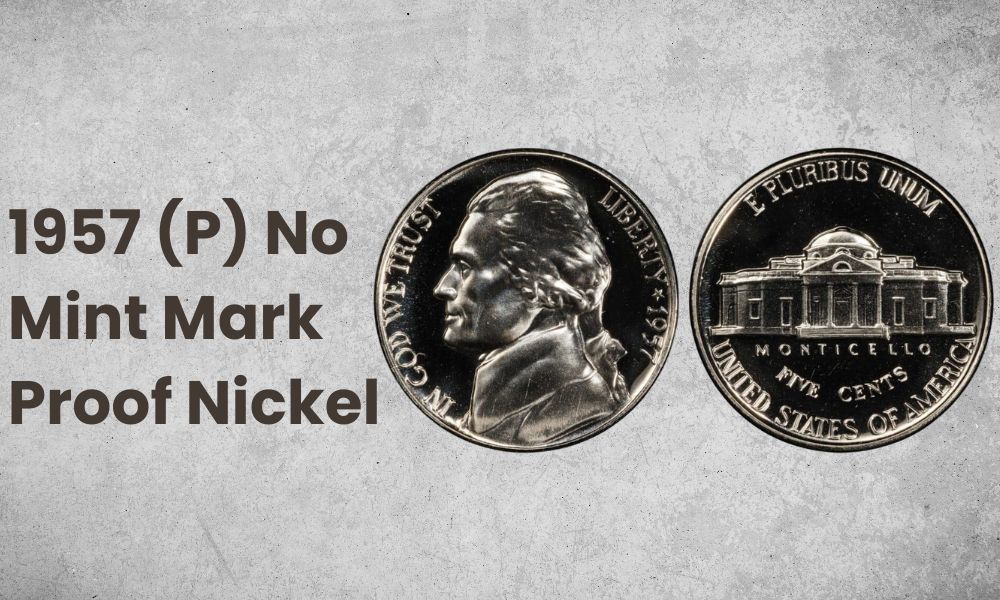
- Type: Jefferson nickel
- Edge: Plain
- Mint mark: None
- Place of minting: Philadelphia
- Year of minting: 1957
- Face value: $0.05
- $ price: $0.05 to $4,000+
- Quantity produced: 1,247,952
- Designer: Felix Schlag
In addition to the regular strikes, the Philadelphia facility produced over a million proof nickels in 1957. These were coins produced to particularly high standards using special dies and planchets.
As they were aimed at the collectors’ market, most of these coins were stored away carefully. That means they’re still readily available at most grades today, keeping prices modest. The lowest graded 1957 proof nickels are graded PR50 and valued at just $2.
Some proofs are further distinguished by the contrast between reflective fields – the flat parts of the coin – and frosted designs. These are known as “cameos” or, if the contrast is particularly strong, “deep cameos”. They command a premium at all grades.
The PCGS values a standard 1957 proof nickel graded PR67 at $20. That increases to $200 if it’s designated a cameo. And a deep cameo nickel at the same grade is valued at $4,000.
Also Read: 15 Most Valuable Nickels Worth Money
History of the 1957 Nickel
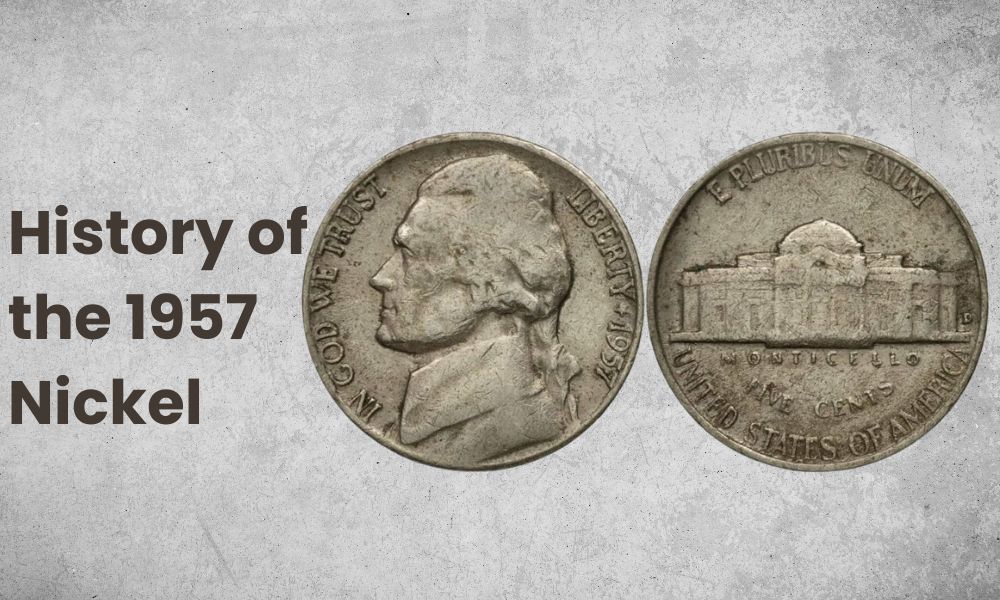
The 1957 nickel is one of the series known as Jefferson nickels. They take their name from the image on the obverse, the former president Thomas Jefferson.
The first Jefferson nickels were produced in 1938 and were made from a combination of copper and nickel. But during the Second World War, nickel became vital to the war effort. From 1942 to 1945, “nickels” were instead made of an alloy of copper, silver and manganese.
Those nickels also had new, larger mint marks to help distinguish them. This included a “P” mint mark for coins struck at the Philadelphia Mint facility. It appeared above the dome of Monticello, and it was the first time the Philadelphia Mint had ever used a mint mark.
In 1946, the coins reverted to their pre-war composition. The “D” mint mark for Denver reverted to its smaller size and former position to the right of Monticello. And mint marks no longer appeared on Philadelphia nickels.
The earliest Jefferson nickels were struck at three Mint facilities: Philadelphia, San Francisco and Denver. The San Francisco mint, however, ceased production from 1954 to 1963. As a result, there are no “S” mint marks amongst 1957 nickels.
The Philadelphia facility also struck proof coins for collectors from 1950 to 1964.
In 1939, the hub – used to create the dies from which coins were struck – was re-cut. The aim was to add more detail to the steps in front of Monticello, which had appeared somewhat fuzzy on the earliest coins.
The change improved the detail on some coins, giving rise to the “Full Step” designation. That’s awarded to nickels where all six steps in front of the building are clearly delineated.
Jefferson nickels are still being produced today. The portrait of Jefferson that appears on the obverse, however, is different.
The original was the work of a German-born sculptor named Felix Schlag. But the image on modern coins was designed by Jamie Franki, based on an earlier portrait by Rembrandt Peale.
Also Read: Top 110 Most Valuable Nickels Worth Money
1957 Nickel Grading
As we’ve seen, the condition of a 1957 nickel is key to determining its value. For regular strikes, whether or not a coin is designated “Full Step” makes a big difference. And for proofs, a cameo or deep cameo designation can add a big premium to their value.
This Youtube video from CoinHELPu looks at a number of graded examples of Jefferson nickels, both regular strikes and proofs. It covers what to look for to see if a coin is “Full Step”. And it will help you decide if it’s worth getting your own Jefferson nickel assessed by a coin grading agency.
1957 Nickel Errors
1957 (P) No Mint Mark Proof Nickel, Quadruple Die Obverse
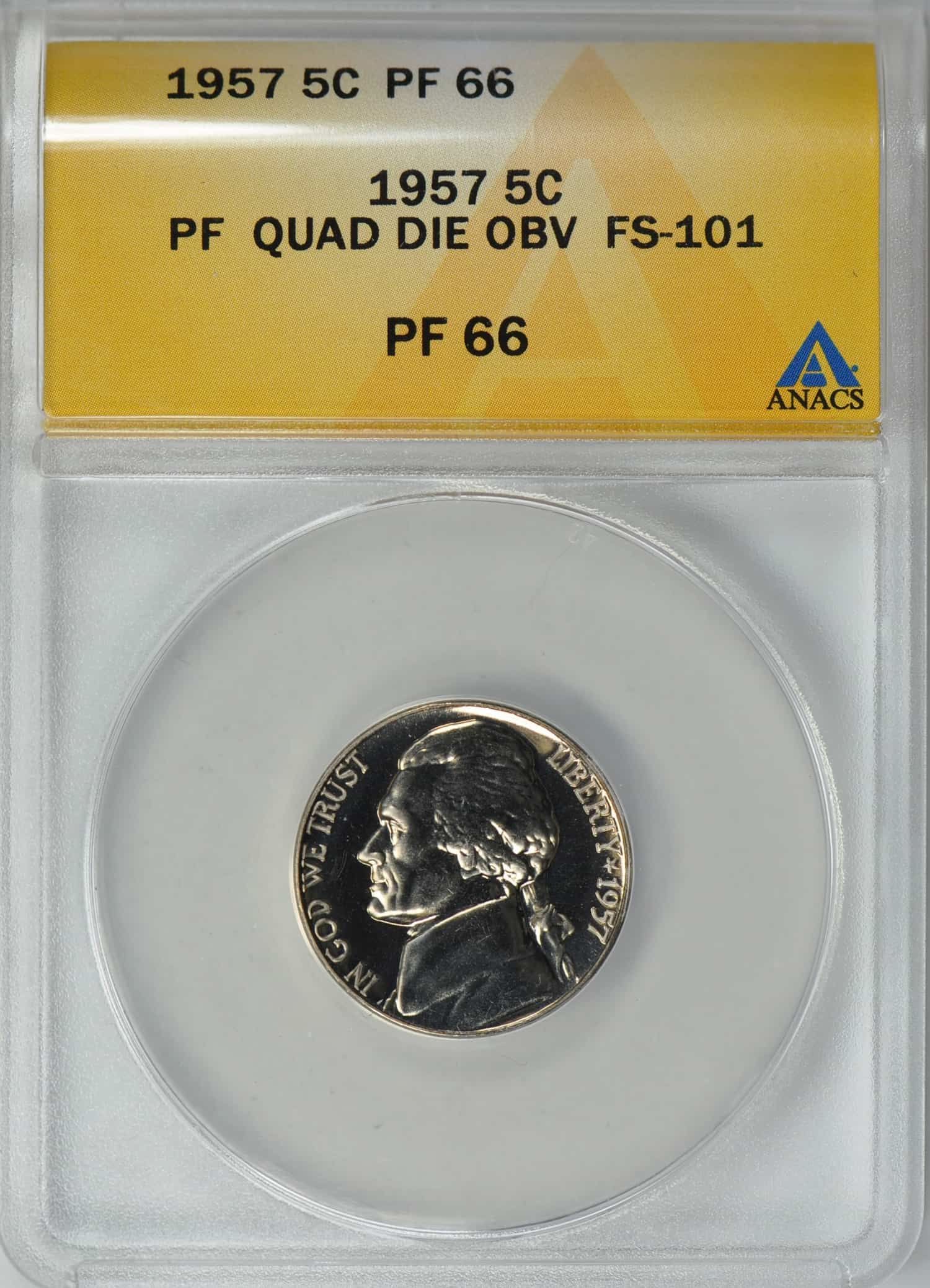
Sometimes an error is made during manufacture of the die from which coins are struck. The dies have to be struck several times with a hub to transfer every detail of the design. But if they move between strikes, more than one image is visible. That’s then transferred to the coins struck by that die.
Most usually the die moves only once, resulting in a double image – what’s known as a double die error. But in 1957, the die used to strike the image of Jefferson on the obverse of proof nickels moved several times. The result was a quadruple die error – four separate images.
Because the error occurs on the obverse, it’s known as a “quadruple die obverse” or QDO. The movement was only slight, so the extra images are hard to spot. You’ll need a coin loupe or microscope for the job.
A coin with this error graded PF67 is valued by the PCGS at $400. An example at this grade last came up for auction in 2017, when it achieved a price of $312.
1957 (P) No Mint Mark Nickel Struck on a Cent Planchet
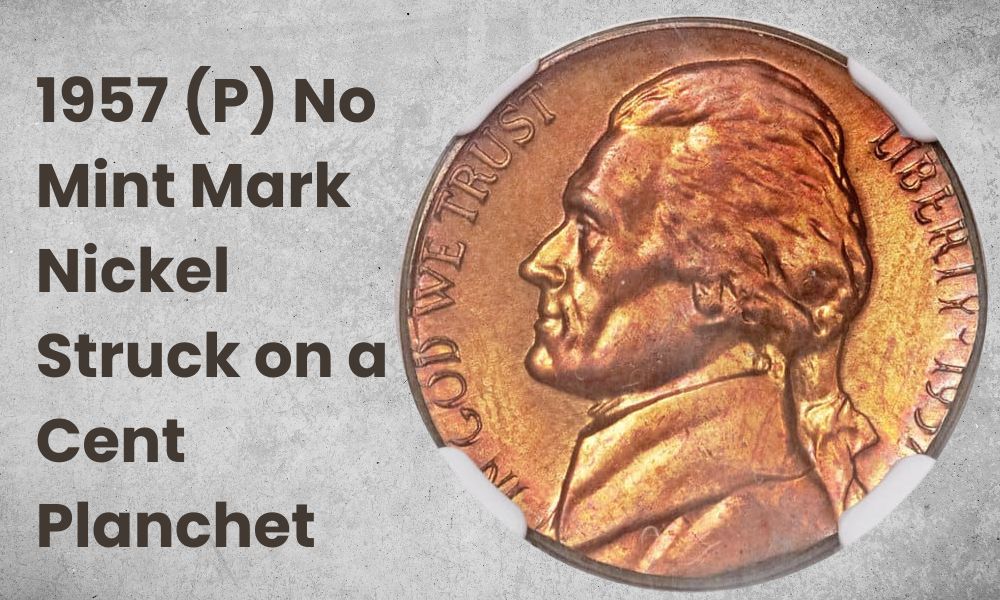
Very rarely, coins are struck on something other than the correct planchet. And that’s what happened to one nickel struck in Philadelphia in 1957. Instead of the 75% copper 25% nickel planchet that should have been used, it was struck on a planchet intended for a one cent piece.
Even as a one cent planchet, it was unusual. A cent dated from 1957 should have weighed 3.11 grams, but this example weighed 3.32 grams. How it came to be made, and how it found itself used for a nickel, remains a mystery.
The coin was graded MS62 red and brown by the NGC. And it sold at auction in 2011 for $863.
This YouTube video from Couch Collectibles shows the quadruple die obverse error on a 1957 nickel. And it also showcases other high quality 1957 nickels that have made big money at auction.
FAQs
Is the 1957 nickel worth anything?
Most circulated coins are worth only their face value, unless they have an interesting error. Coins in the very poorest condition, graded 1, are worth about $10. But coins in mint state – i.e., those that have never been circulated and are in excellent condition – can be worth far more.
Exactly how much more depends on their grade and variety.
The finest example of a 1957 no mint mark nickel is graded MS67 with the “Full Step” designation. That’s worth about $3,500. Coins of this quality with the Denver mint mark – a “D” on the reverse – could be worth even more.
What is special about a 1957 nickel?
Some 1957 nickels are what’s known as “Full Step”, sometimes abbreviated to FS. The designation is awarded to coins with a particularly high quality strike. That means that you can see six distinct steps leading up to Monticello on the reverse of the coin.
Full Step coins are very desirable to collectors. They command a considerable premium over other nickels at the same grade.
What is a 1957 nickel made out of?
The nickels made in 1957 are made of a mixture of three quarters copper and one quarter nickel. It’s the same recipe that was used since they were first produced in 1938.
The nickels made between 1942 and 1945, however, have a different composition. They were made from a mixture of 56% copper, 35% silver and 9% manganese. The new approach was designed to release valuable nickel for the war effort.
Also Read: Top 19 Most Valuable Jefferson Nickels Worth Money
